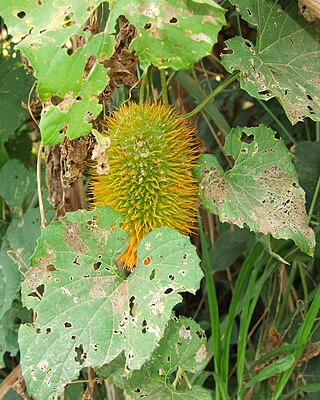
Momordica charantia is a tropical and subtropical vine of the family Cucurbitaceae, widely grown in Asia, Africa, and the Caribbean for its edible fruit. Its many varieties differ substantially in the shape and bitterness of the fruit.

Momordica is a genus of about 60 species of annual or perennial climbers herbaceous or rarely small shrubs belonging to the family Cucurbitaceae, natives of tropical and subtropical Africa and Asia and Australia. Most species produce floral oils and are visited by specialist pollinators in the apid tribe Ctenoplectrini. A molecular phylogeny that includes all species is available.
Alpha-glucosidase inhibitors (AGIs) are oral anti-diabetic drugs used for diabetes mellitus type 2 that work by preventing the digestion of carbohydrates. Carbohydrates are normally converted into simple sugars (monosaccharides) by alpha-glucosidase enzymes present on cells lining the intestine, enabling monosaccharides to be absorbed through the intestine. Hence, alpha-glucosidase inhibitors reduce the impact of dietary carbohydrates on blood sugar.

α-Eleostearic acid or (9Z,11E,13E)-octadeca-9,11,13-trienoic acid, is an organic compound, a conjugated fatty acid and one of the isomers of octadecatrienoic acid. It is often called simply eleostearic acid although there is also a β-eleostearic acid. Its high degree of unsaturation gives tung oil its properties as a drying oil.

Cymbopogon martinii is a species of grass in the genus Cymbopogon (lemongrasses) native to India and Indochina but widely cultivated in many places for its aromatic oil. It is best known by the common name palmarosa as it smells sweet and rose-like. Other common names include Indian geranium, gingergrass, rosha, and rosha grass.

Vernonia amygdalina, a member of the daisy family, is a small to medium-sized shrub that grows in tropical Africa. V. amygdalina typically grows to a height of 2–5 m (6.6–16.4 ft). The leaves are elliptical and up to 20 cm (7.9 in) long. Its bark is rough.

Cucurbitacins are a class of biochemical compounds that some plants – notably members of the pumpkin and gourd family, Cucurbitaceae – produce and which function as a defense against herbivores. Cucurbitacins and their derivatives have also been found in many other plant families, in some mushrooms and even in some marine mollusks.
Charantoside is any of several related cucurbitane triterpenoid glycosides found in the fruits bitter melon vine. They include:
Momordicoside is any of several related cucurbitane triterpenoid glycosides that can be extracted from the bitter melon vine (Momordica charantia). They include:
Goyaglycoside is any of several related triterpenoid glycosides found in the fruits bitter melon vine, called goya in Okinawan language. They include:
Karaviloside is any of several related cucurbitane triterpenoid glycosides found in bitter melon vine. They include:

15,16-Dihydroxy-α-eleostearic acid, or 15,16-Dihydroxy-(9Z,11E,13E)-9,11,13-octadecatrienoic acid, is an organic compound with formula C
18H
30O
4, or H3C-CH2-(-CH(OH)-)2(-CH=CH-)3-(-CH2-)7-(C=O)OH. It can be seen as derived from α-eleostearic acid by the replacement of two hydrogen atoms by two hydroxyl (OH) groups.

Ichnocarpus frutescens is a species of flowering plant in the dogbane family Apocynaceae, known by the English common name black creeper. It is native to much of China, India, Southeast Asia, and northern Australia.

Momordica foetida is a perennial climbing vine native of tropical Africa, closely related to the bitter melon and balsam apple. Its species name ("bad-smelling") refers to its unpleasant smell. It was previously named M. morkorra and M. cordata (Cogn.)
Charantin is a chemical substance obtained from the Asian bitter melon, reputed to be responsible for the hypoglycaemic properties of those plants. It was identified by Lolitkar and Rao in 1960. It was also found in the similar African species M. foetida, by A. Olaniyi in 1975, under the name foetidin.

Momordin or α-momorcharin is one of several related proteins isolated from several plants of the genus Momordica, which includes the bitter melon and the balsam apple.
Momordin is one of several saponins derived from oleanolic acid, a triterpenoid. These chemical compounds are found in some plants of the genus Momordica, which includes the bitter melon and the balsam apple, as well as in other Asian herbal medicine plants such as Kochia scoparia and Ampelopsis radix.

Cucurbitane is a class of tetracyclic chemical compounds with formula C
30H
54. It is a polycyclic hydrocarbon, specifically triterpene. It is also an isomer of lanostane, from which it differs by the formal shift of a methyl group from the 10 to the 9β position in the standard steroid numbering scheme.
A kuguacin is one of several chemical compounds isolated from the bitter melon vine by J.-C. Chen and others.

Cyanotis tuberosa, is a species of plants in the Commelinaceae family.













